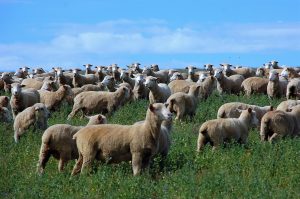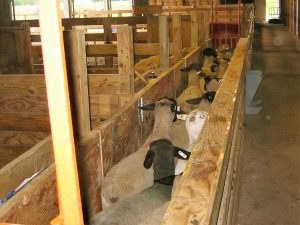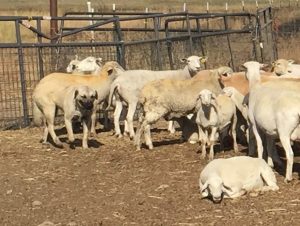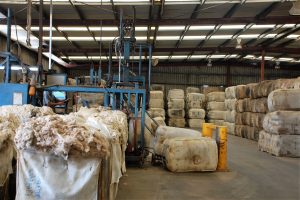 Introduction to Sheep: Sheep production in the state of Washington is diverse and ranging from many types, production settings, climate conditions, and terrain. In addition to WSUE and the small farms team website the Washington State Sheep Producers Association and their National affiliate the American Sheep Industry Association can serve as a professional organization to aid in producer education and support. The sheep industry has been through challenges over the years and the results are alternatives to management and marketing of products that have moved from traditional approaches. This has occurred as a result of consumer demand. The type of operation meat, dairy, fiber, or a combination of production types that you would like to start, may be dictated by: The area of Washington that you reside, the markets that you have access too, the type of additional input that you want to put into the operation and the product (perishable or non-perishable) that you desire to market. Unlike some other livestock systems sheep may have less requirements for facility and facility upgrades. This means that there maybe less expense in starting the operation. Again this will depend on the type of operation. Of course the type of sheep that you are drawn to Hair or fiber will also potentially dictate additional management practices such as shearing (for all wool type sheep). Identifying the resources that you have available at your disposal may help you decide which type of operation to start. Alternative markets for meat and dairy products have widened the opportunities in the sheep industry. With the ethnic trade (in most cases near larger metropolitan areas) there are non-traditional approaches to marketing that have evolved and have created their own niche.
Introduction to Sheep: Sheep production in the state of Washington is diverse and ranging from many types, production settings, climate conditions, and terrain. In addition to WSUE and the small farms team website the Washington State Sheep Producers Association and their National affiliate the American Sheep Industry Association can serve as a professional organization to aid in producer education and support. The sheep industry has been through challenges over the years and the results are alternatives to management and marketing of products that have moved from traditional approaches. This has occurred as a result of consumer demand. The type of operation meat, dairy, fiber, or a combination of production types that you would like to start, may be dictated by: The area of Washington that you reside, the markets that you have access too, the type of additional input that you want to put into the operation and the product (perishable or non-perishable) that you desire to market. Unlike some other livestock systems sheep may have less requirements for facility and facility upgrades. This means that there maybe less expense in starting the operation. Again this will depend on the type of operation. Of course the type of sheep that you are drawn to Hair or fiber will also potentially dictate additional management practices such as shearing (for all wool type sheep). Identifying the resources that you have available at your disposal may help you decide which type of operation to start. Alternative markets for meat and dairy products have widened the opportunities in the sheep industry. With the ethnic trade (in most cases near larger metropolitan areas) there are non-traditional approaches to marketing that have evolved and have created their own niche.
 Sheep Production and Management: Sheep production can vary depending on the type of operation, production type (meat, fiber, or dairy) and niche’ or traditional marketing approach. The type of operation and the production type will dictate management decisions such as feed resources (pasture, hay, grain, supplements, etc.,), housing requirements, environment, management and care, and may define marketing channels (organic, all natural, pasture raised, grain-fed, etc.,) as a result of how you raise and care for your sheep. Setting goals and business plane for any sheep operation is paramount to the success of your operation. Regardless of a hobby or a business it is important to at the least recoup your costs. Many large sheep operations are not diversified engaging other production systems (another specie and or crop). Many small to medium size operations with sheep may have a diversified approach with either animal and/or plant or crop based environment. Diversification will offer the opportunity to capitalize on multiple markets.
Sheep Production and Management: Sheep production can vary depending on the type of operation, production type (meat, fiber, or dairy) and niche’ or traditional marketing approach. The type of operation and the production type will dictate management decisions such as feed resources (pasture, hay, grain, supplements, etc.,), housing requirements, environment, management and care, and may define marketing channels (organic, all natural, pasture raised, grain-fed, etc.,) as a result of how you raise and care for your sheep. Setting goals and business plane for any sheep operation is paramount to the success of your operation. Regardless of a hobby or a business it is important to at the least recoup your costs. Many large sheep operations are not diversified engaging other production systems (another specie and or crop). Many small to medium size operations with sheep may have a diversified approach with either animal and/or plant or crop based environment. Diversification will offer the opportunity to capitalize on multiple markets.
The following link will aid new or established producers understanding basic sheep production. Meeting the basic needs, defined in Sheep Production and Management, is paramount to good stewardship of sheep.
- Sustainable Sheep Production Livestock Production Guide. By Ann Wells, Lance Gegner & Richard Earles, NCAT Agriculture Specialists, 2000. Published by ATTRA–National Sustainable Agriculture Information Service. PDF available at: https://attra.ncat.org/publication/sheep-sustainable-and-organic-production/
Sheep Nutrition:  Proper nutrition for sheep will assist in meeting production goals at varying stages of production through out the year for your operation. It will assist you in keeping sheep healthy meeting their nutritional needs. The primary component of nutrition is balance for the stage of production that they are in. Many assume that grass and/or grain will offer the same end result. However, this will depend on the stage of production as requirements change. When we compare a dry ewe with a lactating ewe with lambs at side, the dry ewe has a low energy requirement where as the lactating ewe requires more energy maximizing her performance as she has more demands. Understanding forage, grains, and supplements or additive feeds will allow you to use items that will not only improve production but will also allow you to select the most cost effective items possible. Nutritional programs should be formulated and developed based on the target stage of production and then adjusted accordingly. Formulated feeds from some of the popular feed companies can make things easy when you’re first starting out. These feeds maybe a good starting point and will meet basic needs of your sheep however these are formulated for the most common sheep needs and may not be specific to your operational needs. Working with a reputable and trained nutritionist will help to meet your goals and maximize your feed budget and production goals.
Proper nutrition for sheep will assist in meeting production goals at varying stages of production through out the year for your operation. It will assist you in keeping sheep healthy meeting their nutritional needs. The primary component of nutrition is balance for the stage of production that they are in. Many assume that grass and/or grain will offer the same end result. However, this will depend on the stage of production as requirements change. When we compare a dry ewe with a lactating ewe with lambs at side, the dry ewe has a low energy requirement where as the lactating ewe requires more energy maximizing her performance as she has more demands. Understanding forage, grains, and supplements or additive feeds will allow you to use items that will not only improve production but will also allow you to select the most cost effective items possible. Nutritional programs should be formulated and developed based on the target stage of production and then adjusted accordingly. Formulated feeds from some of the popular feed companies can make things easy when you’re first starting out. These feeds maybe a good starting point and will meet basic needs of your sheep however these are formulated for the most common sheep needs and may not be specific to your operational needs. Working with a reputable and trained nutritionist will help to meet your goals and maximize your feed budget and production goals.
- Feeding Sheep. By Stephen H. Umberger, Extension Animal Scientist, Virginia Tech. May 2009.
 Sheep Health: Another key component important to production efficiency is the health of your sheep flock. Understanding how to care for your sheep will reduce illness, disease and parasites and will improve efficiency of your flock. Additionally this will assure bio-security on ranch/farm. Determining a bio-security plan can sometimes be a daunting task. A few key things can help with this. First and foremost determining the type of operation that you are running and the calendar of events. By doing this you should have a set schedule for annual vaccinations and sheep health management concerns. Secondly, establishing a Veterinary Client Patient Relationship. This can be a simple meet and greet allowing you to work with a local medical professional on health concerns through out the management year. Arranging a good relationship with your vet will set the stage for proper health care and management for your sheep operation. One challenge is finding a vet that deals with sheep and other small ruminant species. The sooner you can address a change in behavior as a result of poor health the sooner you can treat and minimize the effect it may have.
Sheep Health: Another key component important to production efficiency is the health of your sheep flock. Understanding how to care for your sheep will reduce illness, disease and parasites and will improve efficiency of your flock. Additionally this will assure bio-security on ranch/farm. Determining a bio-security plan can sometimes be a daunting task. A few key things can help with this. First and foremost determining the type of operation that you are running and the calendar of events. By doing this you should have a set schedule for annual vaccinations and sheep health management concerns. Secondly, establishing a Veterinary Client Patient Relationship. This can be a simple meet and greet allowing you to work with a local medical professional on health concerns through out the management year. Arranging a good relationship with your vet will set the stage for proper health care and management for your sheep operation. One challenge is finding a vet that deals with sheep and other small ruminant species. The sooner you can address a change in behavior as a result of poor health the sooner you can treat and minimize the effect it may have.
Tube Feeding Small Ruminants. By Dr. Susan R. Kerr, Regional Livestock Specialist, WSU Extension publication (EB 1998).
Sheep Predator Control:  Predators, both wild and domestic, can pose a threat to sheep. When predators attack a sheep flock the result could be death, injury and extreme stress subsequently affecting performance. Management of sheep and the environment that they exist in will minimize the effect of predators. Facilities, fencing, animal movement, use of guard animals and working with wildlife services in order to track potential problem predators are paramount to a successful predator control program. From a legal stand point it is important to know what you can and cannot do with regard to predators. Some predators are protected species and it is far better to know your rights and limitations. Working with local government (state and federal) to determine your mode of defense. Predators may not always be wild, domestic dogs can wreak havoc on sheep of any age. Your operation may be close to a residential area where owners have dogs. Again knowing your rights and how to protect your sheep is your responsibility. Being proactive may not stop all of the predator attacks but it may minimize the extent and the number of attacks that you experience in your operation.
Predators, both wild and domestic, can pose a threat to sheep. When predators attack a sheep flock the result could be death, injury and extreme stress subsequently affecting performance. Management of sheep and the environment that they exist in will minimize the effect of predators. Facilities, fencing, animal movement, use of guard animals and working with wildlife services in order to track potential problem predators are paramount to a successful predator control program. From a legal stand point it is important to know what you can and cannot do with regard to predators. Some predators are protected species and it is far better to know your rights and limitations. Working with local government (state and federal) to determine your mode of defense. Predators may not always be wild, domestic dogs can wreak havoc on sheep of any age. Your operation may be close to a residential area where owners have dogs. Again knowing your rights and how to protect your sheep is your responsibility. Being proactive may not stop all of the predator attacks but it may minimize the extent and the number of attacks that you experience in your operation.
- Predator Control for Sustainable and Organic Livestock Production. 2002. By NCAT Staff. ATTRA Publication #IP 196.
- Sheep and Lamb Predator and Non-Predator Death Loss in The United States in 2015. September 2015. United States Department of Agriculture. http://www.aphis.usda.gov/nahms
Sheep Processing and Value-Added Products:  Lamb products have been consumed at a stagnant rate within the US. The average annual per capita consumption is 0.8 lbs. Having said that there is a consumer trend evolving as a result of ethnicity and foods that appeal to consumers that desire something different. This change in ethnicity, facilitating a new direction in consumer demand with lamb and sheep products, have created a shift in the type of carcasses that are being harvested depending on the target markets. Ethnic trade changes have resulted from an increasing population of ethnic decent (Hispanic, Middle Eastern, etc.). Further the food revolution has created opportunities for a growing dairy industry with regard to liquid and solid food such as yogurt and cheese made from sheep milk. Likewise the cottage and fiber arts industry has helped to develop many markets for wool and hair from sheep and lamb origin. The value of the products that you sell, are dependent on customers that you serve. As with many other animal production systems sheep and lamb have alternatives to the traditional or conventional market. Consumers are looking for low price point regardless of their economic status. Many consumers (of meat, dairy and fiber) want a story about how that animal was raised and the care that it was given. Adding that personal touch could allow you to price your item higher than conventional markets.
Lamb products have been consumed at a stagnant rate within the US. The average annual per capita consumption is 0.8 lbs. Having said that there is a consumer trend evolving as a result of ethnicity and foods that appeal to consumers that desire something different. This change in ethnicity, facilitating a new direction in consumer demand with lamb and sheep products, have created a shift in the type of carcasses that are being harvested depending on the target markets. Ethnic trade changes have resulted from an increasing population of ethnic decent (Hispanic, Middle Eastern, etc.). Further the food revolution has created opportunities for a growing dairy industry with regard to liquid and solid food such as yogurt and cheese made from sheep milk. Likewise the cottage and fiber arts industry has helped to develop many markets for wool and hair from sheep and lamb origin. The value of the products that you sell, are dependent on customers that you serve. As with many other animal production systems sheep and lamb have alternatives to the traditional or conventional market. Consumers are looking for low price point regardless of their economic status. Many consumers (of meat, dairy and fiber) want a story about how that animal was raised and the care that it was given. Adding that personal touch could allow you to price your item higher than conventional markets.
- Niche Meat Processors Assistance Network’s Mobile Slaughter Unit Manual. April 2010. Lauren Gwin. Niche Meat Processors Assistance Network.
- Island Grown Farmers Co-op. IGFC provides USDA-inspected mobile animal slaughter services to members and non-members in San Juan, Whatcom, Skagit, Island and Snohomish counties in Washington State.
- Puget Sound Meat Producers Cooperative. The PSMPC is a non-profit cooperative of local ranchers, farmers, butchers, restaurant owners and others joined in the operation of a mobile, USDA-inspected meat processing unit initially servicing King, Kitsap, Lewis, Mason, Pierce, and Thurston counties.
- San Juan Farmers’ Plan is a Cut Above, 11-26-2001. Lynda V. Mapes, Seattle Times Newspaper. Farmers hope to operate an on-farm slaughtering unit to support local growers on the San Juan Islands in Puget Sound.
- American Lamb – Fabricating for Value Video. Kuber, P.S., WSUE formerly from The Ohio State University. Produced Published and Distributed by the American Lamb Board
Photo Credits: All photos on this page courtesy of Paul Kuber, WSU (formerly of Ohio State University Extension).